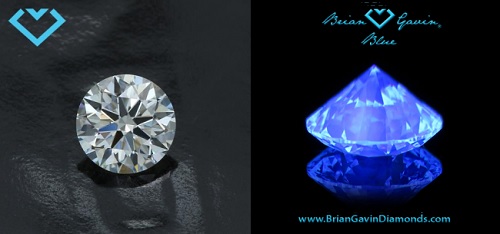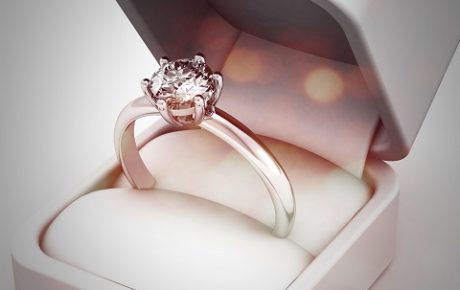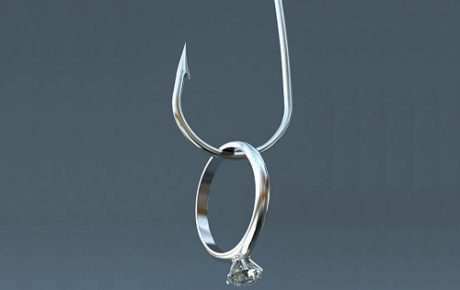10 Fun Facts About Diamonds And Things You Didn’t Know

Diamonds have long been associated with prestige and romance. However, did you know it wasn’t always like that? We actually learned to love diamonds through clever marketing by someone reining the lines (read on to find out who).
Caught your attention, didn’t I?
Right then, let’s take a break away from the usual technical stuff and do something else today. Let’s take a look at some fun diamond facts and trivia most people don’t know about.
Fact #1 – Your Diamonds Are Probably Billions Of Years Old
The oldest diamonds that scientists have discovered are estimated to date back billions of years ago. While diamonds themselves cannot be carbon dated, scientists can date the surrounding materials that were transported up the volcanic pipes together with the diamonds. This enables the age of the diamonds to be estimated based on the carbon dating results.
Fact #2 – A Huge Portion of Diamonds Glow Under Black Light (UV)

A fluorescent diamond viewed in office lighting and black lighting.
Two-thirds of naturally mined diamonds will exhibit a degree of bluish fluorescence when observed under ultraviolet light. This is a neat feature to make people go “WOW!” in the disco. You can also take advantage of this feature by using it to test the authenticity of your diamond.
Even though not every diamond will fluoresce, cubic zirconium stones never will. That is, if your stone fluoresces, it is a good indicator of authenticity when checked alongside its lab report.
Fact #3 – 80% of American Consumers Overpay for Diamond Jewelry
Call it naivety or stupidity, there are many unprepared shoppers who have no idea what they are buying and simply trust their jeweler blindly. Did you know that the average American diamond buyer ends up paying twice what the gemstone is actually worth?
If you want to avoid becoming part of the statistics, get yourself educated before going down to the store. Make sure you fully understand the 4Cs, look up the differences between terms like “carat weight” and “carat total weight” and compare prices of different services (even if you shop online).
For peace of mind, you should only buy from a reputable retailer and consider hiring an independent appraiser to size up your purchase.
Fact #4 – Diamonds Are Not Rare
Large volumes of diamonds are available at mines all over the world. You’ve heard me right. Don’t believe me? The world reeled in shocked when Russia revealed a mine that could fuel worldwide supply for three thousand years.
However, only a tiny portion of mined diamonds is of gem-quality and turned into jewelry. The rest of the mined roughs are generally used for industrial applications. Yet, even that small percentage of gem-quality roughs are more than sufficient to satisfy the world’s demand for diamond jewelry on a worldwide basis.
To avoid over-flooding the market with diamonds and driving down the value of a commodity, the distribution and supply of diamonds are carefully controlled by big cartels like De Beers (currently owning about 60-70% of the world’s supply). By limiting the flow of diamonds to the market, De Beers created an artificial scarcity in the market by making sure that diamonds will not be accessible to everyone.
This leads us to the next point…
Fact #5 – A Diamond is Forever.

Three stone engagement ring signifying past, present and future
Well, at least we were made to believe in this statement. Whether you own any type of jewelry or made diamond purchases before, you probably heard of the century’s most famous advertisement slogan. The brainchild behind this famous quote is none other than De Beers.
Back in the 1930s, De Beers hired N.W. Ayer & Son and placed them in charge of creating a need in the consumer market for diamonds. That’s when the phrase “A diamond is forever” was created in a stroke of marketing ingenuity.
From Hollywood to mainstream TV shows, the lives of men around the world were changed once the campaign was launched. Guys, now you know who to blame for making your lives difficult?
Fact #6 – Poorly Cut Diamonds Flood the Entire Market
Almost 90% of polished diamonds are intentionally cut to standards beneath their full potential. This is done to preserve the maximum carat weight from the rough diamond instead of achieving a diamond with better optical performance.
Why?
The answer is obvious if you study how diamonds are priced. A larger diamond gives the jeweler a bigger profit margin compared to a smaller diamond that is ideally cut.
If a diamond is “accidentally” polished to remove an additional 0.02 carats from a one carat stone, the value of the stone could be potentially 40-50% less! This is because diamonds are primarily valued by weight more than any other factors like color or clarity.
Fact #7 – The Market is Full of Treated And Enhanced Diamonds
Slightly more than a third of the diamonds sold in the United States had undergone one or more methods of enhancements. These could include clarity treatment processes or color enhancements.
I want to go on the record saying that a treated diamond is usually going to be a really bad purchase because of the garbage tier quality of such diamonds. What you do need to know is that the jeweler is lawfully obliged to declare any such treatments according to the FTC.
Obviously, treated diamonds are going to be worth a lot less than untreated stones and you should be paying the correct kind of pricing for them.
Fact #8 – There’s A Place Where You Can Dig Your Own Diamonds

Did you know that the Crater of Diamonds State Park in Arkansas is a place where you can legally search for a diamond and keep what you find? The park is a diamond bearing volcanic pipe that yields white, yellow and brown tinted diamonds.
If you are feeling lucky and want to try your hand at digging for a diamond, you should visit the park. The record of the largest diamond ever found in the park is a 40.23 carat white diamond nicknamed the Uncle Sam Diamond.
Fact #9 – Nature Isn’t the Only Source of Diamonds
Scientists have come up with techniques of vaporizing carbon in Chemical Vapor Deposition (CVD) which can yield synthetic diamonds of the highest clarity grades. Without advanced equipment and knowledge, synthetics can be very hard to be differentiated from the real stuff.
This gives us another reason why I always emphasize the need for having a reliable diamond certificate. No matter what happens in laboratories, real diamonds are formed over millions of years and impregnated with the sweat of workers. That in itself will be incomparably worth more than synthetic diamonds.
And if you are one of the people who hope the prices of diamonds will see a definitive crash with the introduction of synthetics, you can continue to pray hard. Do you think large companies involved in lab-grown diamonds like Gemesis would purposely flood the market with cheap diamonds even if they could?
It doesn’t take an MBA degree to tell you that it would result in collateral damage. Nobody (except consumers) would benefit from a decrease in diamond prices. Why would people in the synthetic business do this when they could keep prices as high as possible for a larger profit margin?
Fact #10 – Diamonds in Outer Space
While scanning the galaxies for Earth-like planets, scientists have discovered white dwarf stars that are made of diamond cores. Could you imagine a diamond the size of 10 billion carats in weight and weighing more than 2 thousand trillion tons?
If there’s a way to mine the white dwarf, we would literally hit the diamond jackpot!
With that, I hope you enjoyed reading this article. Hopefully, you had gained a better awareness and discovered a little more knowledge about diamonds. If we missed any interesting diamond facts here, feel free to leave a comment below and add your own.
Buying Diamond Jewelry? This May Interest You!
Whether you are shopping for an engagement ring or simply looking at ideas for diamond jewelry, you can find a wide selection of GIA certified diamonds and beautifully crafted jewelry pieces at James Allen.

Related Articles
Leave A Comment














3 Comments
I didn’t realize that most diamonds are used for industrial things rather than for jewelry. That’s really interesting. My boyfriend and I are getting really close to getting engaged. I think that I’d like to find somewhere to look at diamonds before so that I can give him an idea of what I’d like on the ring.
Thanks for the cool facts about diamonds. Yes, a diamond is forever that means a never-ending sign of love and the youngest diamond is almost 250 million years old, and the oldest is around 3 billion.
Our love for diamonds is engineered. I’m a marketing student and happened to read about the case study for the marketing campaign.
As early as the 4th century BC, there is evidence that diamonds were traded in India and were highly prized by royalty. However, the mainstream desire for diamond jewelry was masterfully engineered by De Beers in the 1940s.
They created a wildly successful marketing campaign and coined the phrase “A Diamond is Forever” to fuel demand for the diamonds. At that time, De Beers had a monopoly on the supply of diamonds and made a lot of money by selling diamonds for engagement rings. So, they had very clear vested interest in marketing diamonds for the average consumer.